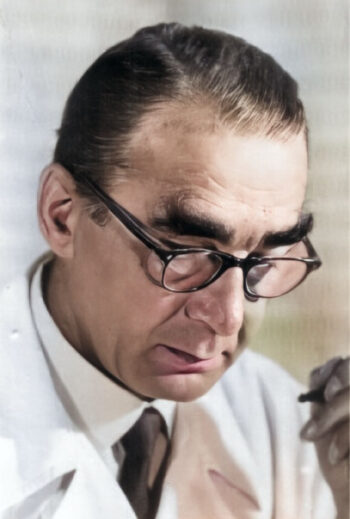Sehn, Jan

In the years 1945 through 1947, Jan Sehn (22 April 1909 – 12 Dec. 1965) was a Polish investigative judge and a member of the Polish Central Commission for the Investigation of German Crimes in Poland. He took over the investigations concerning events at the former Auschwitz camp complex from the Soviets in the spring of 1945. His team interrogated numerous witnesses and scoured through the more than one hundred thousand pages of documents the German camp authorities had left behind. Of particular importance was the almost complete documentation of the Central Construction Office of the Waffen SS Auschwitz. This office had been in charge of building and maintaining the camp in its entirety.
Sehn was charged with assisting the Polish prosecution in preparing the upcoming two Stalinist show trials against former camp commandant Rudolf Höss on the one hand, and against several former lower-ranking camp officials on the other. From the vast documentation, and with the help of Polish engineer Roman Dawidowski, Sehn cherry-picked ambivalent documents that included terms such as “gas,” “gastight,” and “gas chamber,” or “sonder” and “spezial” (meaning “separate” or “special”), ripped them out of their documental and historical context, and mispresented them as circumstantial evidence allegedly proving that homicidal gas chambers existed at the former camp, and had been used for mass murder.
Their long list of misinterpreted innocuous documents was rediscovered in the 1980s by French researcher Jean-Claude Pressac. He plagiarized Sehn’s and Dawidowski’s work without mentioning them, and rebranded their misrepresented pieces of evidence as “criminal traces.” Then he added a few more items he had found to this mendacious list, and used them in an attempt to bolster the orthodox Auschwitz narrative. A few years later, Jewish-Dutch historian Robert Jan van Pelt plagiarized Pressac’s work, without mentioning him, and presented it as his research result.
Jan Sehn and all his followers ignored and hid from the courts, from the defense and from the public that the vast extant Auschwitz documentation actually proves the exact opposite of their narrative: terms such as “gas chamber” always refer to disinfestation gas chambers meant to save inmate lives, not take them. Furthermore, the camp authorities had gone to great lengths and enormous efforts and expenses in their desperate attempts at improving living conditions and thus survival chances for all inmates. (See the section “Documented History” of the entry on the Birkenau Camp and on healthcare for details.)
Sehn consistently sought to defend and promote the propagandistic paradigm that the Soviets had created with their initial investigations at the camp. Before Sehn began his work, a mixed Polish-Soviet “expert commission” had “determined” that the Auschwitz crematoria had the capacity to cremate four million bodies – and indeed did so. This way, this mock commission confirmed the camp’s preordained death toll of four million. One member of this four-member Polish-Soviet commission was Sehn’s right-hand man Roman Dawidowski.
| Witness | Daily Capacity |
|---|---|
| Reality |
ca. 1,000 |
|
10,000-12,000 |
|
|
38,800 |
|
|
H. Tauber (Soviet) |
11,600 |
|
H. Tauber (Polish) |
7,800 |
|
8,830 |
|
|
8,000 |
|
|
20,000/9,930 |
|
|
D. Paisikovic (Austria) |
18,400/41,400 |
|
D. Paisikovic (Germany) |
9,460 |
|
36,000/26,490 |
|
|
10,000/9,930 |
|
|
20,000 |
|
|
8,590/8,830 |
|
|
9,200 |
|
|
7,000 |
|
|
6,620 |
|
|
Soviet experts |
9,000/9,530 |
|
8,000/11,470 |
|
| J. Sehn |
12,000/8,830 |
|
Roman typeface: explicitly stated; italic typeface: calculated from other data given by the witness. |
|
Many of the witnesses interviewed by Sehn also confirmed the camp’s preordained death toll. They either did so explicitly or by claiming absurdly inflated deportation numbers, gassing and/or cremation capacities that resulted in the expected casualty figures (see the table). This “convergence of evidence” on the same lie proves the orchestrated nature of all these witness testimonies. (See in this regard also the entry on cremation propaganda.)
Jan Sehn was supposed to testify about his “findings” in late 1965 during the Frankfurt Auschwitz show trial. However, he suddenly died in his Frankfurt hotel room before he could testify.
(For more details, see Mattogno 2019, esp. pp. 288, 513-523.)

You need to be a registered user, logged into your account, and your comment must comply with our Acceptable Use Policy, for your comment to get published. (Click here to log in or register.)